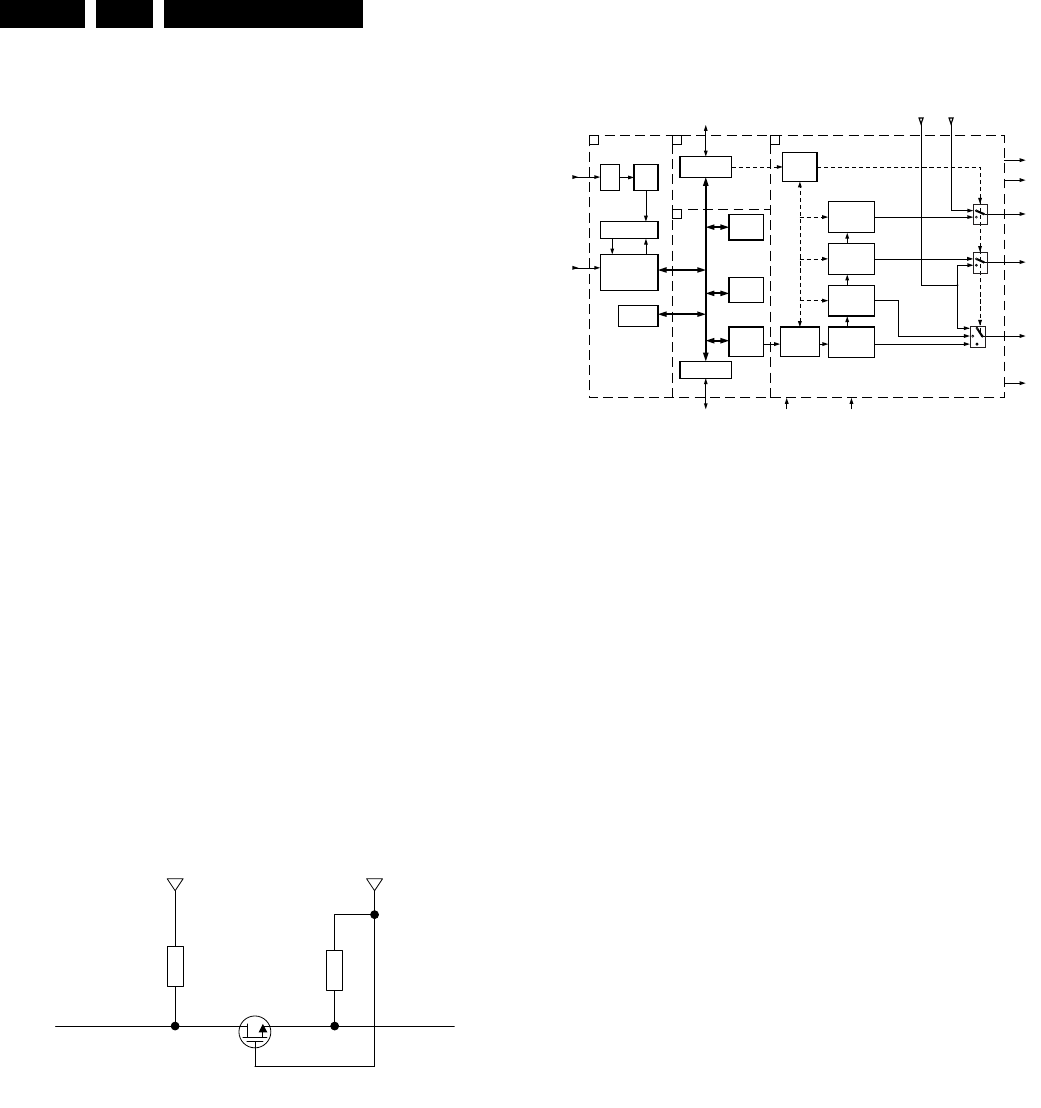
Circuit Descriptions and List of Abbreviations
EN 70 DVD763SA9.
Signal Processing
For video, the input data stream is decoded to the appropriate
MPEG, Sub Picture, and OSD data streams, after which they
are fed to the PAL/NTSC encoder. This cell will convert the
digital MPEG/Sub Picture/OSD stream into a standard base
band signal and into RGB components. It handles interlaced
and non-interlaced data, can perform CC/TXT encoding, and
allows MacroVision copy protection.
For audio, the processing cell is a fully compatible DTS, Dolby
Digital (AC-3), MPEG1, MPEG2, PCM decoder, capable of
decoding 5.1 and 2 channel streams.
Output
For video, six analogue output pins are available on which
CVBS, S-VHS (Y/C), and RGB signals are present. They go,
via a buffer, to connector 1703. As an option, a digital YUV
output is available at connector 1704.
External Memory
The STi55xx family is capable of accessing external memory
via three buses:
• The enhanced memory interface (EMI). This interface is
configurable and can be used to access Flash, ROM, and
various flavours of DRAM.
• The shared memory interface (SMI). The SMI is only
used to access SDRAM. The SMI is connected to a
64Mbits (4M x 16bit) 7.5ns SDRAM (item 7500). The
SDRAM has the following functions:
– It is used by the MPEG video decoder as a frame
buffer,
– It holds the software and the variables used by it.
• The I2C bus. Via this bus, the NVRAM (or EEPROM) is
accessible. This memory is used to store user settings,
player settings, and region code. As the STi55xx I/O-lines
are potentially unable handle 5V inputs, a voltage level
shifter is foreseen for all I2C-busses. This circuit will isolate
the STi55xx I2C ports (3.3V) from the system I2C bus (5V).
See figure below.
Figure 9-5 I2C voltage level shifter
The SACD DSD processor
The Furore-IC is a one-chip design, containing all the hardware
that is required for SACD processing. It is intended to interface
with the STixx-family DVD video decoders.
The Furore-IC contains a memory interface to support an
external 16 or 64 Mbit SDRAM.
During SACD application, the STi55xx serves as a host,
whereby the Furore is controlled via the EMI interface. The
Furore processing part is not used during all other play modes.
In these modes, the PCM audio signals are fed through the
Furore to the appropriate DAC.
Block diagram
Figure 9-6 Block diagram Furore
We can divide the Furore-IC in four main parts (see block
diagram):
1. Host interface. This is the link between the host bus and
the internal registers and memory bus. It also supplies the
general reset signal (HW and SW) and the interrupt
signals.
2. Data processing. All modules and peripherals in this part
are connected to a so-called PI-bus. It is beyond the scope
of this manual to go more in detail on this subject.
3. Copy protection. On every SACD disc, a PSP-signal is
recorded. The player can only play a disc if a valid PSP-
signal is detected. This PSP-key is recorded, via a special
mechanism, in the EFM-signal on the disc. To detect this
key, the analogue HF-signal from the optical pick-up unit is
fed directly to the Furore-IC. Via an AGC, the signal is fed
to an ADC. The digitised HF signal is then fed to a block
where key is encrypted. Control of this process is done via
the host interface (sector processor).
4. DSD decoding and post processing. In this part, all
processing is done to generate a DSD and/or an I
2
S stream
(from the de-multiplexed stream coming from the data
processing block), in such a way that it can directly be
connected to a DA-converter. All processing is done on
384*FS.
Interfaces
• Basic Engine Interface:
– Data input interface. The Basic Engine Interface (I2S)
is connected to the output of the SAA7335 (HD61) high
speed CD decoder.
– Analogue HF input. The analogue HF input, coming
from the optical pickup unit (OPU), is also fed to the
Furore-IC, to extract the copy-protection information
PSP (Pit Signal Processing = invisible data is stored on
to disc, which is required to decrypt the encrypted
content).
• SDRAM Interface: The SDRAM interface forms a glue
less interface to one 64 Mbit SDRAM device. The interface
takes care for the power-up sequence, mode programming
and refreshing of the SDRAM devices. This is hard coded
in the interface and does not have to be controlled by the
host.
• Audio data input/output Interface:
– DSD/PCM combined data output. DSD_PCM: Output
intended for a combined 6-channel DSD (SACD) and
PCM (DVD-CDDA) DAC. Switching between the PCM
data coming from the STi55xx, and the internal
generated DSD signals, is done in the Furore IC.
– Stereo DSD only output. DSD_stereo: 2-channel DSD
output with stereo down mix in the case of 5- and 6-
channel, and normal stereo in case of 2-channel DSD
mode.
3V3
3k3
5V
3k3
(optional)
5V I2C levels 3.3V I2C levels
CL 16532163_050.eps
230102
Decryption
/
Sector
Processor
AGC
8 bits
AD
PSP-key
decoder
Key
Host interface
Demux
SDRAM
interface
SACD
Audio
interface
PI-Bus
Control
2 -5 -6 ch
LossLess
decoder
6 channel
fade
To Host processor
(STi 55XX)
From Host processor
(STi 55XX)
to 16 Mbit/64 Mbit
SDRAM
PCM_CLK
PI-bus
Control
Register
Host
interface
DSD
mix
IEC 958
gen.
DSD -->PCM
(stereo)
AUD_CLK
256/384/512/718
*
FS
FS = 44.1 - 48 KHz
PCM
I
2
S
I
2
S
HF
Memory
manager
SYS_CLK
27-35 MHz
CL 26532053_021.eps
260402
(BE Interface)
3 41
2
DSD_CLK
IEC 958
PCM
DSD/PCM
MUTE
IEC 958
